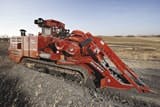| Tables: |
|---|
|
It’s understandable why someone trying to sell utility equipment these days would steer clear of listening to or reading the daily business news. The plunge of the new housing market is, as the mass message goes, reason for people to stay in bed and pull the covers over their heads. But it’s not all doom and gloom for Greg Adkins when he hears the news.
Adkins is trencher product manager for Ditch Witch, and he’s been hearing plenty about plans for wind farms, big wind farms, billions of dollars worth of wind farms. That, indeed, could be considered get-out-of-bed-at-the-crack-of-dawn news for Ditch Witch, which pushed its trencher product line upward in model size with last year’s introduction of the 220-horsepower HT220 and is about to go another step up with the 300-horsepower HT330, which is set for introduction in the latter half of this year. Both the HT220 and the HT330 are built to Ditch Witch specifications by Tesmec, which specializes in larger trencher technology.
“There’s a ton of infrastructure that has to go on with any of those wind farms,” says Adkins. “There’s no overhead transfer of power; everything’s underground. And probably one of the biggest things about wind farms is that they like putting them up in solid rock conditions.”
That, Adkins teases about the yet-unveiled HT330, will be a good fit.
Following a path rivals have already forged, Ditch Witch is expanding from its rubber-tired utility trencher market to the world of the larger track trencher — a connection that hinges at or just above the 100-horsepower size. Utility market rivals Vermeer, Ditch Witch and Astec each offer one four-wheel-drive unit in the 115- to 120-horsepower range, where the crossover to track trenchers begins in earnest. Ditch Witch and Vermeer, for instance, offer both wheeled and tracked versions of their models in that range.
For Astec, which has its Trencor family of machines to compete against the likes of Trench-Tech, Tesmec and Vermeer in the large and behemoth trencher market, the most recent addition was actually at that “hinge” point — the 115-horsepower, four-wheel-drive RT1160. The productivity of a hydrostatic trencher drive featuring a two-speed motor with variable chain speeds in either range is combined with the operational ease of electronic controls and an open operator’s platform. “We’re trying to fill some of the gaps that Case didn’t fill in the marketplace,” says Bob Wren, training manager with Astec Underground. “We want to satisfy as much of the rubber-tired market as we can. We’re trying to expand into the marketplace where we need to be to meet our competition.”
Wren, a 26-year Case veteran who harkens back to the Case Davis days, followed the former Case trencher line to Astec upon the 2003 acquisition of the line.
“A lot of our utility contractors, even today, are putting PVC and cable and wire in the ground for same price they did 10, 12, 14 years ago. The only way they can make any money is to do it efficiently — faster — so machine productivity is very important,” says Wren. “Product reliability is a big thing, too. A machine that’s going to go out there and stay on the job five days a week and work 8-10 hours a day, that’s what the contractor’s got to have.
“The RT1160 has all the comforts that a machine operator could ask for — suspension seat, flat platform, electric-over-hydraulic controls. Everything that every utility contractor has asked us to have on a tractor, this one’s got it,” says Wren. “But those components have to be reliable and, in the atmosphere that a trencher or a cable plow works in — the dust, the dirt, the rain, the snow, the ice, the mud, the clay — the nature of the beast is difficult on components. You start putting electronic components and computers on machines that work out there in the tough environment, they have to be reliable.”
Astec will be offering a cab for the RT1160 by the end of the fourth quarter, says Wren.






